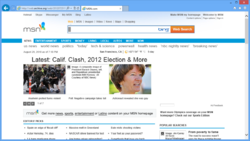Internet Explorer 10
| Version of Internet Explorer | |
 | |
| Version | 10.0 |
|---|---|
| Compatible with | Windows 7 SP1 Windows Server 2008 R2 SP1 Windows 8 Windows Server 2012 |
| Release date | 2012-09-04 |
| Support end | 2016-01-12 2020-02-11 (Windows Server 2012, Windows Embedded 8 Standard) |
| About |  |
Internet Explorer 10 is the tenth version of Internet Explorer. It shipped with Windows 8 and Windows Server 2012 as the default browser and was also made available for Windows 7 SP1 and Windows Server 2008 R2 SP1. It replaced Internet Explorer 9 and was replaced by Internet Explorer 11. Internet Explorer 10 for Windows 7 and Windows Server 2008 R2 was released on 26 February 2013.
Development history[edit | edit source]
Internet Explorer 10 was first announced on 12 April 2011 at the MIX11 conference in Las Vegas. At the conference, Microsoft showcased a demo version of Internet Explorer 10 alongside a pre-release version of Windows 8. On the same day, a Platform Preview of Internet Explorer 10 was released on the Microsoft Internet Explorer Test Drive website. It only supports Windows 7; later platform preview releases only support Windows 8. IE 10 Platform Preview 1 includes support for CSS3's grid layout, flexible box layout, multi-column layout, gradients, and GPU hardware acceleration.
At the time of its release, Platform Preview 1 performed better than its predecessor but was still considered slow compared to other competitors.
On 13 September 2011, at the first Microsoft Build conference, Microsoft released the Developer Preview of Windows 8 to the general public, which shipped with the Internet Explorer Developer Preview (the first full browser incarnation of it). It reached general availability on 26 October 2012, alongside Windows 8, and with Windows Server 2012, which shipped earlier on 4 September 2012. A preview of Internet Explorer 10 for Windows 7 and Windows Server 2008 R2 was released on 13 November 2012.
New features[edit | edit source]
Adobe Flash Player[edit | edit source]
Under Windows 8 and Server 2012 (if install Desktop Experience component using Server Manager), Internet Explorer 10 includes a built-in copy of Adobe Flash Player. Microsoft worked with Adobe to develop a special build of Flash that would ensure improved battery life and performance. In the "Metro" version of Internet Explorer, Flash has further disabled features to meet those goals and to remain compatible with Metro's enhanced security. Certain mouse-centric features that do not work well with touch displays have also been removed.
Originally, not all websites could use the built-in Flash support under Metro. Microsoft and Adobe maintained a whitelist of approved domains that contained video content and games, unlike the desktop version. On 12 March 2013 Microsoft changed this behavior from allowing only sites from the whitelist to display Flash content, to allow all sites to display Flash content except for those on a curated Compatibility View list (blacklist) maintained by Microsoft.
Flip Ahead[edit | edit source]
Internet Explorer 10 introduced a new feature called Flip Ahead, available under Desktop and Metro builds. Flip Ahead adds a touch gesture that can be used to flip back and forth on sites that use multiple pages, replacing the need to tap on small page controls. This feature is turned off by default as browsing history is sent to Microsoft in order to provide it. Microsoft stated that some sites would need to be updated to ensure the gesture would work as intended.
Metro UI[edit | edit source]
The Metro version of Internet Explorer 10 available on Windows 8 and Server 2012 (not enabled by default) includes a new UI, most of which is hidden so that the webpage being viewed takes up the entire screen. This version is only accessible when Internet Explorer is set as the default browser. The UI can be revealed by a right click of the mouse or by a swipe from the top or bottom edges of a touchscreen. When the UI is shown, current tabs are listed on the top of the screen, with a small preview of the page on each tab. A button to add a new tab is placed in the top-right corner. At the bottom of the screen, the address bar and navigational buttons are shown. Navigational buttons include the Back button (to navigate to the previous page), the Refresh button (to reload the active page), the Pin button (which create a new shortcut tile for the active page on the Start screen), and a wrench-shaped icon, which opens the only menu under Metro. It contains options such as "View on Desktop", which opens the current webpage on the desktop version of IE 10, and "Find on page", which can find a text string (a word, phrase, or arbitrary set of letters) in the active page.
Metro version running on Windows Developer Preview
Metro version running on Windows 8 RTM
Discontinued features[edit | edit source]
- Conditional comments in HTML (though JavaScript conditional comments still work)
- DirectX-based filters and transitions (DX filters)
- Element Behaviors and HTML Components (HTCs)
- XML Data Islands
- Vector Markup Language (VML)
- Content Advisor (replaced by Windows Parental Controls or Microsoft Family Safety)

